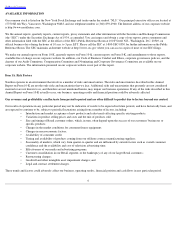Nautilus 2012 Annual Report Download - page 21
Download and view the complete annual report
Please find page 21 of the 2012 Nautilus annual report below. You can navigate through the pages in the report by either clicking on the pages listed below, or by using the keyword search tool below to find specific information within the annual report.
Table of Contents
Deferred Tax Assets
- Valuation Allowance
We account for income taxes based on the asset and liability method, whereby deferred tax assets and liabilities are recognized for the future tax
consequences attributable to differences between the financial statement carrying amounts and the tax basis of existing assets and liabilities.
Deferred tax assets and liabilities are measured using the enacted tax rates that are expected to be in effect when the temporary differences are
expected to be included, as income or expense, in the applicable tax return. The effect of a change in tax rates on our deferred tax assets and
liabilities is recognized in the period of the enactment. A tax benefit from an uncertain tax position may be recognized when it is more likely
than not that the position will be sustained based on the technical merits of the position upon examination, including resolutions of any related
appeals or litigation.
We have recorded a valuation allowance to reduce our deferred tax assets to the amount we believe is more likely than not to be realized. As we
determined, based on reviewing all the positive and negative evidence, that it is more likely than not that the benefit from our deferred tax assets
will not be realized, we have a valuation allowance against net deferred tax assets of $57.2 million
. If our assumptions change and we determine
we will be able to realize these deferred tax assets, the tax benefits related to any reversal of the valuation allowance will be accounted for in the
period in which we make such determination. Likewise, should we determine that we would be able to realize our deferred tax assets in the
future in excess of our recorded amount, an adjustment to the deferred tax assets would increase income in the period such determination was
made.
Significant judgments are required in determining tax provisions and evaluating tax positions. Such judgments require us to interpret existing tax
law and other published guidance as applied to our circumstances. In particular, our valuation allowance contains uncertainties because
management is required to make assumptions and to apply judgment to estimate the future realization of net deferred tax assets. If our financial
results or other relevant facts change, thereby impacting the likelihood of realizing the tax benefit of an uncertain tax position, significant
judgment would be applied in determining the effect of the change on our valuation allowance.
16
























